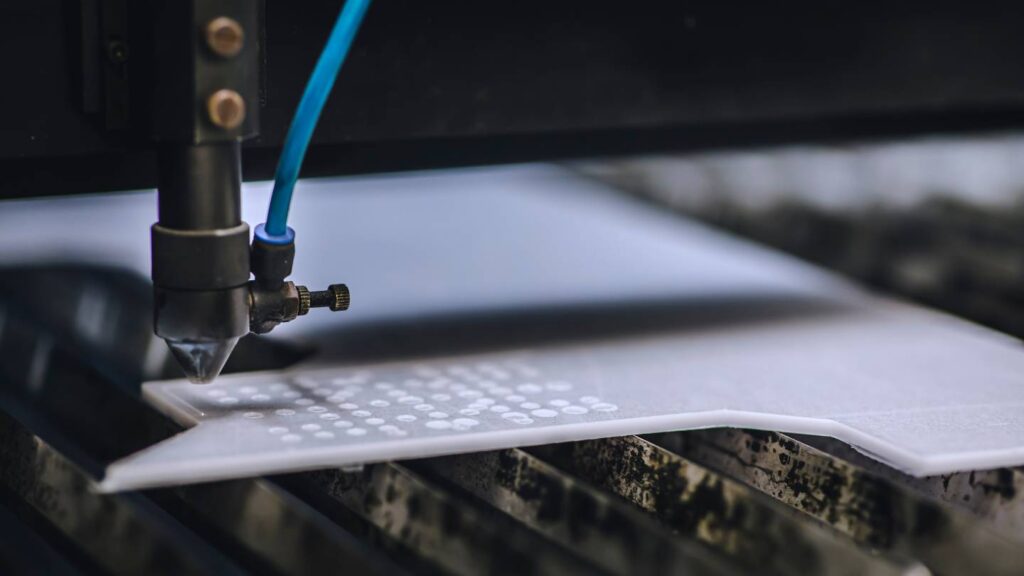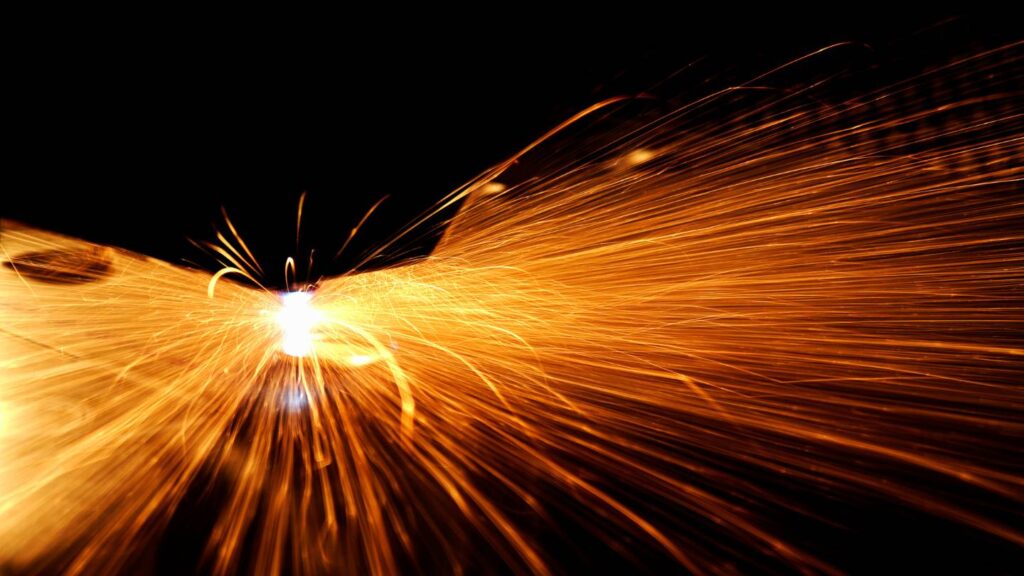Laser cutting has become a cornerstone of modern manufacturing, celebrated for its unmatched precision and efficiency.
This technology’s ability to produce intricate, accurate components has made it indispensable across various industries, from automotive to aerospace. But what exactly contributes to the exceptional accuracy of laser cutting?
This blog will explore the key elements that make laser cutting one of today’s most precise manufacturing techniques.
Let’s get straight to the point
Laser cutting’s exceptional accuracy is driven by a combination of factors, including the quality of the laser beam, advanced computer control systems, and precise motion controls.
The technology’s versatility in handling various materials and advancements like fibre lasers and real-time monitoring further enhance its precision.
Additionally, environmental stability and operator expertise are crucial in maintaining high accuracy.
These elements make laser cutting a vital tool in industries requiring intricate and precise manufacturing, such as aerospace and medical devices.

Understanding Laser Cutting Technology
Laser cutting uses a concentrated light beam to cut, etch, or engrave materials precisely. This beam, typically only a fraction of a millimetre in diameter, delivers high energy to a specific point on the material, causing it to melt, burn, or vaporise, resulting in a clean cut.
The process is computer-controlled, ensuring that the laser follows the path necessary to produce the desired shape or pattern.
The precision of laser cutting stems from the characteristics of the laser beam itself. The beam is coherent and monochromatic, meaning all the light waves are in phase and of the same wavelength.
This coherence allows the laser to maintain a narrow focus over considerable distances, cutting through materials with unparalleled accuracy.
What Role Does the Quality of the Laser Beam Play in Laser Cutting Accuracy?
High Focus Intensity
The beam’s focus intensity largely determines the precision beam’s cutting. Concentrating energy into a small, intense spot is crucial for achieving clean, precise cuts.
A narrower beam reduces the heat applied to surrounding areas, minimising the risk of warping or other heat-induced distortions. This ensures the laser cuts only where intended, leaving the surrounding material unaffected.
Minimal Heat-Affected Zone (HAZ)
The minimal heat-affected zone (HAZ) is a critical factor in enhancing laser cutting accuracy.
Unlike other cutting methods where heat can spread and alter the properties of the surrounding material, the ‘laser’s beam minimises the area impacted by heat.
This results in sharper edges and cleaner cuts, essential for industries requiring high-precision components, such as electronics or medical devices.
How Do Advanced Computer Control Systems Affect Laser Cutting Accuracy?
Precision in Path Following
One of the standout features of laser cutting machines is their advanced computer-controlled systems. These systems guide the laser with pinpoint accuracy, ensuring it follows the exact path dictated by the design.
This high level of precision allows even the most intricate patterns to be replicated with minimal deviation, a necessity in industries like aerospace, where even minor errors can have significant consequences.
Automated Adjustments for Consistency
Modern laser-cutting machines continuously monitor and adjust the laser’s operation to maintain accuracy.
Whether compensating for slight material variations or adjusting the laser as it moves across different sections, these automated adjustments ensure consistent precision throughout the cutting process.
This is particularly crucial in high-volume manufacturing environments where tight tolerances must be met.
How Do Material Properties Affect Laser Cutting Accuracy?
Versatility Across Materials
Laser cutting’s rate is partly because it is versatile for handling various materials. Whether cutting metals, plastics, wood, or ceramics, the laser can be adjusted to suit each material’s properties.
This adaptability is vital, as different materials respond differently to heat and light. For instance, metals generally require a more intense beam, while plastics may need a lower intensity to avoid melting.
Fine-tuning the laser for each material type ensures precise cuts while maintaining material integrity.
Handling Different Material Thicknesses
Material thickness significantly influences cutting accuracy. Thinner materials generally allow for more precise cuts since the laser can penetrate them more easily.
The laser might need to make multiple passes for thicker materials, which could slightly reduce overall accuracy.
However, advancements in laser cutting technology have largely mitigated these issues, enabling precise cuts even on thicker materials.
Addressing Reflectivity Challenges
High-reflectivity materials like aluminium or copper can challenge laser cutting by reflecting the laser beam and reducing cutting accuracy.
However, modern laser-cutting machines overcome this by employing more powerful lasers or using fibre lasers designed specifically for reflective materials.
These innovations have made it possible to achieve high accuracy even with previously difficult-to-cut materials.
Why Are Motion Control Systems Critical for Laser Cutting Accuracy?
High-Precision Motion Systems
The accuracy of laser cutting heavily depends on the motion control systems that guide the laser head.
These systems ensure the laser moves smoothly and precisely along the intended cutting path. Any deviation can lead to inaccuracies, especially in complex designs requiring tight tolerances.
High-quality motion control systems minimise these deviations, allowing for the accurate replication of intricate designs.
Balancing Speed and Accuracy
In laser cutting, there is often a trade-off between speed and accuracy. While faster cutting speeds can increase productivity, they can sometimes compromise cut quality.
Modern laser-cutting machines balance this trade-off effectively by optimising the laser’s speed and focus, achieving high accuracy even at faster cutting speeds.
This capability is particularly valuable in industries where speed and precision are critical, such as automotive manufacturing.
How Do Environmental and Operational Factors Impact Laser Cutting Accuracy?
Thermal Management
The operating environment can significantly impact a laser-cutting machine’s accuracy.
Thermal stability is critical; significant temperature fluctuations in the machine or material can cause distortions, affecting cut accuracy.
To counteract this, many laser-cutting machines have sophisticated cooling systems that maintain stable operating temperatures, ensuring consistent and accurate performance.
Minimising Vibrations
Vibrations in the cutting environment can also affect laser accuracy. Even small vibrations can cause the laser beam to shift slightly, leading to deviations from the intended cutting path.
To mitigate this, laser cutting machines are typically mounted on heavy, stable frames designed to minimise vibration, with some incorporating vibration-dampening technology to enhance precision further.
What Technological Advancements Are Improving Laser Cutting Accuracy?
The Rise of Fiber Lasers
One of the most significant advancements in laser cutting technology is the development of fibre lasers.
These use a solid-state laser source and offer advantages over traditional CO2 lasers, such as greater energy efficiency, smaller spot size, and the ability to cut reflective materials more effectively.
These qualities make fibre lasers ideal for high-precision applications where even the slightest deviation could be problematic.
Real-Time Monitoring Systems
Modern laser cutting machines increasingly feature real-time monitoring systems that track various aspects of the cutting process.
These systems use sensors to monitor laser performance, material conditions, and environmental factors. If anomalies are detected, the system can adjust the laser’s speed or focus in real time to maintain accuracy.
This capability is particularly valuable for maintaining consistency across large production runs.

How Does Operator Expertise Contribute to Laser Cutting Accuracy?
Skilled Operators and Accuracy
While laser-cutting machines are highly automated, the accuracy of the final product still depends significantly on the operator’s expertise. Skilled operators understand the nuances of different materials and the specific settings required to achieve optimal results.
Their ability to troubleshoot issues during the cutting process ensures that the machine operates at peak performance, a crucial factor in producing precision components, especially in industries like medical device manufacturing or aerospace.
Continuous Training and Development
Operators must undergo continuous training to maintain and enhance accuracy. As laser cutting technology evolves, new techniques and best practices emerge, improving precision.
By staying updated on these advancements and incorporating them into their workflows, operators can ensure their machines consistently produce high-accuracy results.
This commitment to ongoing learning is essential in an industry where technological advancements occur frequently and rapidly.
Conclusion
Laser cutting’s exceptional accuracy results from several interrelated factors: the high-quality laser beam, advanced computer controls, precise motion systems, and adaptability to various materials.
Environmental controls and operator expertise are also crucial in maintaining and enhancing this accuracy.
As laser cutting technology continues to evolve, even greater levels of precision are likely, further solidifying its position as an indispensable tool in modern manufacturing.

